Outside my window: Nature hidden in suburbia
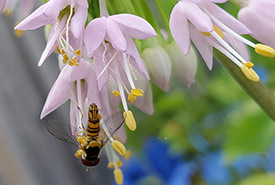
Oblique streaktail on my wild nodding onion plant (Photo by Wendy Ho/NCC staff)
Over the summer, I’ve tried to be attentive and notice the nature in my eight-square-metre backyard. It’s where I can make unhurried observations without the looming thought of hogging the trail from fellow hikers. And you know what? There’s often more that meets the eye in my little urban landscape in the Greater Toronto Area.
Experiencing nature from the macro to micro
The way I experience nature falls in within a spectrum of macro-observations to micro ones. Sometimes, I indulge in the sensory stimulation from the whole environment: taking in the fresh air and dappled sunlight without minding the details. Other times, I crave knowledge and go micro in my observations to learn about every plant or critter I encounter, which slows my pace significantly. And in my yard is where I intently examine nature’s workings.
How I find nature when there seems to be none
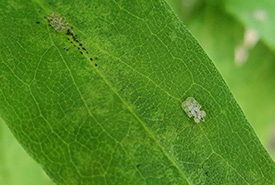
Two chrysanthemum lace bugs on a New England aster leaf. The yellow stippling on the leaf shows that the bugs have been feeding on it. (Photo by Wendy Ho/NCC staff)
Seeking nature in your backyard might seem boring at first, if you're unsure what to look for. But with time and patience, something is bound to catch your attention. There are easily observable insects, like butterflies and bumble bees, and there are those that I need to squint at to get a good look, like small hoverflies and chrysanthemum lacebugs. Here, in my little suburban oasis, is where I picked up on how to enjoy nature without any agenda.
What is my subject doing in that moment?
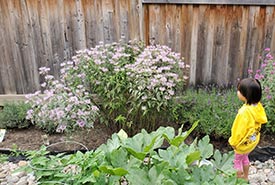
My 4.5-year-old watching bees on the wild bergamot plants (Photo by Wendy Ho/NCC staff)
First, I always make sure I stay still (at a distance that doesn’t interfere with the wildlife’s activities) to watch them go about their business before I pull out my phone to get a picture for identification (check out these photography tips). Sometimes, the critters are so small that my phone camera is unable to focus. I have to get a mental picture of the species’ main characteristics for identifying later.
What’s in a name?
Finding the name of my subject always leads me down a rabbit hole of reading fun facts. Sometimes, the investigation connects me to an online community of nature lovers who join in on the sleuthing. In my suburban neighbourhood, the critters are often common and sometimes non-native or invasive species. Each learned name adds to my mental library of what exists in this neighbourhood.
Mundane yet magical moments
While my observations may not be eureka moments, seeing something for the first time gives me a great sense of discovery. Even with familiar plants or insects, watching their form and behaviour in the moment allows me to appreciate their presence and company. I often catch myself mentally rattling off every fact I know about a species, but often in doing so, my mind dismisses the uniqueness of that individual right before my eyes.
Here are five of many highlights over my summer in this eight-square-metre yard:
Mourning doves
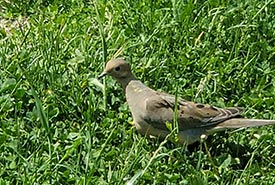
An unremarkable photo of a mourning dove. One of the birds that I actually put my phone down for to just enjoy their company. (Photo by Wendy Ho/NCC staff)
Another day, another mourning dove visits the bottom of my bird feeder. It’s sitting among the long unmowed clovers and dandelions, seemingly without a care in the world, soaking in the sun’s warmth. As BirdNote podcast shared, birds like mourning doves like to sit and extend their wings to sun themselves, and one theory goes that this behaviour helps drive out parasites. I would have missed that if I saw these doves every time and thought of them as ordinary. I enjoy the slow pace at which they forage, unbothered by humans.
Bumble bees
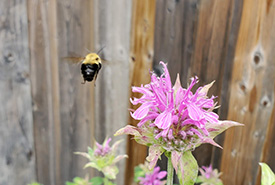
Bumble bee flying toward a wild bergamot flower. (Photo by Wendy Ho/NCC staff)
Another favourite backyard activity is standing near my wild bergamot patch and watching bumble bees forage. Wild bergamot, a native plant that ranges from Quebec to British Columbia, attracts bees, butterflies and hummingbirds. Many times, I find chubby common eastern bumble bees sipping nectar from the tubular flower lips. Bumble bees don’t seem perturbed when I stand motionless and close by, so close I can hear their buzz and watch their long tongue reach far into the flower.
A butterfly taking a pee, or is it?
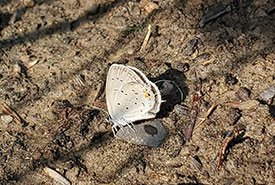
Eastern tailed-blue perched on a small rock. A wet spot on the rock was created by liquid dripping from the butterfly’s abdomen. (Photo by Wendy Ho/NCC staff)
One evening after supper, I was making my usual rounds around my garden when I found a small butterfly atop a rock. I was going to take a picture but in waiting for the lens to focus, I saw a drop of liquid drip out from the butterfly’s behind. And it let out what I thought was a drop of urine every 15 seconds or so. I later learned that it was an eastern tailed-blue and it was probably getting a drink from the moisture on the ground or “licking” the ground to get minerals. Sometimes, butterflies will excrete a drop of water from their abdomen, known as recycling, to help dissolve the minerals.
Milkweed visitors
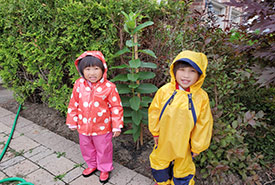
Common milkweed grew from a short plant to one taller than my daughters, in fewer than two months! (Photo by Wendy Ho/NCC staff)
Back in spring, a single unusual weed popped up, which I later confirmed was a second-year common milkweed. Ironically, I’ve been trying to plant milkweed for years with no success. So this gift from nature had me jumping for joy. In less than two months, it grew from 10 to 150 centimetres tall, and I found a tiny monarch caterpillar on the underside of one of its leaves. Unfortunately, the caterpillar didn’t survive (it is estimated that only five to 10 per cent of caterpillars reach adulthood), but the fact that I now have a host plant that will grow again next year is amazing. Recently, something else has been nibbling on the leaves. Turns out it’s another native bug called red milkweed beetle.
Two-legged giggle monsters
There are two more creatures I regularly observe: my preschoolers. They’ve made many interesting finds too, from the spongy moth caterpillars to spiders and dragonflies. I can’t remember the last time when I squealed with delight from the bottom of my heart. But in watching children interact with nature, I re-experience the things that even I brush off as mundane through their fresh eyes.
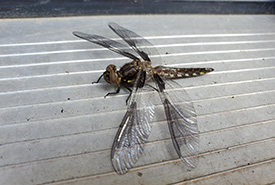
My 2.5-year-old found a common whitetail dragonfly resting on our doorstep (Photo by Wendy Ho/NCC staff)
These experiences motivate me to continue to participate in initiatives like No Mow May and native plant gardening. Because if my eight-square-metre yard can sustain some native wildlife, can you imagine how many more can be supported if neighbours welcomed native plants into their spaces, creating a suburban corridor of habitat? One of my goals for the next few years is to incorporate native plants in my front yard, including the boulevard area, and include small garden signs with plant names and the wildlife they support.
For more information on how to support urban biodiversity, find out what you could do for your Small Acts of Conservation.


